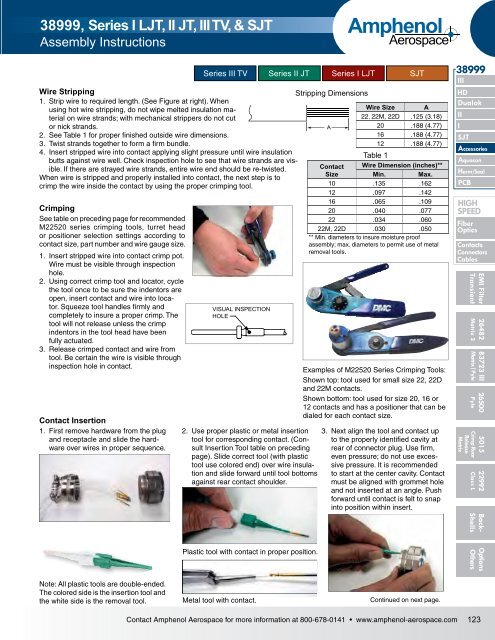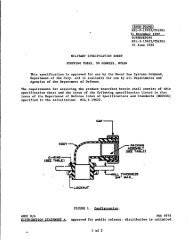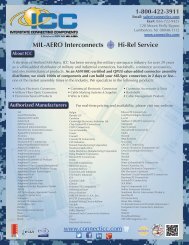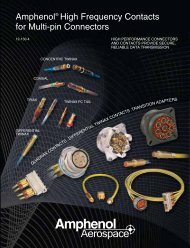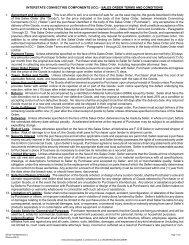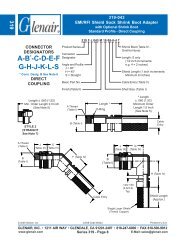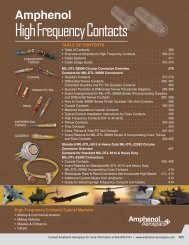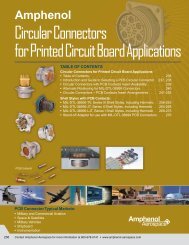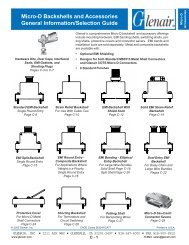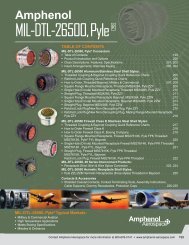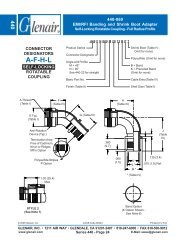- Page 1 and 2:
Amphenol Products for Military, Aer
- Page 3 and 4:
Amphenol Aerospace Amphenol Aerospa
- Page 5 and 6:
Amphenol Aerospace Amphenol New Pro
- Page 7 and 8:
Amphenol Aerospace MIL-DTL-38999, S
- Page 9 and 10:
Amphenol Aerospace MIL-DTL-38999, S
- Page 11 and 12:
Amphenol Aerospace MIL-DTL-38999, S
- Page 13 and 14:
Amphenol Aerospace MIL-DTL-38999, S
- Page 15 and 16:
Amphenol Aerospace MIL-DTL-38999, S
- Page 17 and 18:
Amphenol Aerospace MIL-DTL-38999, S
- Page 19 and 20:
Amphenol Aerospace MIL-DTL-38999, S
- Page 21 and 22:
Amphenol MIL-DTL-38999, Series III,
- Page 23 and 24:
Amphenol Aerospace MIL-DTL-38999, S
- Page 25 and 26:
Amphenol Aerospace MIL-DTL-38999, S
- Page 27 and 28:
38999 HD Dualok II I SJT EMI Filter
- Page 29 and 30:
Amphenol Aerospace Boeing BACC63 Ho
- Page 31 and 32:
38999 III HD Dualok II I SJT Access
- Page 33 and 34:
38999 HD Dualok II I SJT EMI Filter
- Page 35 and 36:
38999 III HD Dualok II I SJT Access
- Page 37 and 38:
38999 III HD Dualok II I SJT Access
- Page 39 and 40:
38999 HD Dualok II I SJT EMI Filter
- Page 41 and 42:
38999 III HD Dualok II I SJT Access
- Page 43 and 44:
Amphenol Aerospace D38999/29 & D389
- Page 45 and 46:
38999 III HD Dualok II I SJT Access
- Page 47 and 48:
EMI Filter Transient 26482 Matrix 2
- Page 49 and 50:
38999 III HD Dualok II I SJT Access
- Page 51 and 52:
38999 III HD Dualok TV01( II CTV01(
- Page 53 and 54:
38999 III HD Dualok II I SJT Access
- Page 55 and 56:
Amphenol Aerospace Custom Designed
- Page 57 and 58:
Amphenol Aerospace High Vibration D
- Page 59 and 60:
38999 III HD Dualok II I SJT Access
- Page 61 and 62:
38999 III HD Dualok II I SJT Access
- Page 63 and 64:
38999 III HD Dualok II I SJT Access
- Page 65 and 66:
38999 III HD Dualok II I SJT Access
- Page 67 and 68:
38999 III HD Dualok II I SJT Access
- Page 69 and 70:
Amphenol Aerospace JT00R (MS27472)
- Page 71 and 72:
Amphenol Aerospace JT01R Series II
- Page 73 and 74: 38999 III HD Dualok II I SJT Access
- Page 75 and 76: Amphenol Aerospace JTG06R (MS27484)
- Page 77 and 78: Amphenol Aerospace JTL07R Series II
- Page 79 and 80: Amphenol Aerospace JT00 (MS27475) S
- Page 81 and 82: Amphenol Aerospace JT00 (MS27334) S
- Page 83 and 84: Amphenol Aerospace JT07 (MS27337) S
- Page 85 and 86: Amphenol Aerospace LJT00R (MS27466)
- Page 87 and 88: Amphenol Aerospace LJT01R Series I
- Page 89 and 90: Amphenol Aerospace LJT06R (MS27467)
- Page 91 and 92: Amphenol Aerospace LJT00 (MS27469)
- Page 93 and 94: 38999 III HD Dualok II I SJT Access
- Page 95 and 96: 38999 III HD Dualok II I SJT Access
- Page 97 and 98: Amphenol Aerospace Series I, LJT Br
- Page 99 and 100: Amphenol Aerospace Amphenol SJT Fea
- Page 101 and 102: Amphenol Aerospace SJT Insert Avail
- Page 103 and 104: Amphenol Aerospace SJTP02RE - Crimp
- Page 105 and 106: Amphenol Aerospace SJTIY - Hermetic
- Page 107 and 108: Amphenol Aerospace MIL-DTL-38999 Ba
- Page 109 and 110: Amphenol Aerospace MIL-DTL-38999, S
- Page 111 and 112: Amphenol Aerospace MIL-DTL-38999, S
- Page 113 and 114: Amphenol Aerospace MIL-DTL-38999, S
- Page 115 and 116: 38999 III HD Dualok II I SJT Access
- Page 117 and 118: Amphenol Aerospace MIL-DTL-38999, S
- Page 119 and 120: Amphenol Aerospace SJT - Accessorie
- Page 121 and 122: 38999 III HD Dualok II I SJT Access
- Page 123: Amphenol Aerospace 38999, Series I
- Page 127 and 128: Amphenol Aerospace Aquacon Immersib
- Page 129 and 130: Amphenol Aerospace Aquacon Series I
- Page 131 and 132: Amphenol Aerospace AJ Aquacon Inser
- Page 133 and 134: Amphenol Aerospace AJ6 / AS6 Aquaco
- Page 135 and 136: Amphenol Aerospace AJ7 / AS7 Aquaco
- Page 137 and 138: Amphenol Aerospace Aquacon Series P
- Page 139 and 140: Amphenol Aerospace Aquacon Series C
- Page 141 and 142: Amphenol Aerospace Amphenol High Sp
- Page 143 and 144: 38999 III HD Dualok II I SJT Access
- Page 145 and 146: Amphenol Aerospace Amphenol ® Circ
- Page 147 and 148: Amphenol Aerospace Circular Connect
- Page 149 and 150: Amphenol Aerospace Circular Connect
- Page 151 and 152: Amphenol Aerospace Circular Connect
- Page 153 and 154: Amphenol Aerospace Circular Connect
- Page 155 and 156: Amphenol Aerospace Circular Connect
- Page 157 and 158: Amphenol Aerospace Circular Connect
- Page 159 and 160: Amphenol Aerospace Circular Connect
- Page 161 and 162: Amphenol Aerospace Circular Connect
- Page 163 and 164: Amphenol Aerospace Circular Connect
- Page 165 and 166: 38999 III HD Dualok II I SJT Access
- Page 167 and 168: 38999 III HD Dualok II I SJT Access
- Page 169 and 170: 38999 III HD Dualok II I SJT Access
- Page 171 and 172: 38999 III HD Dualok II I SJT Access
- Page 173 and 174: 38999 III HD Dualok II I SJT Access
- Page 175 and 176:
38999 III HD Dualok II I SJT Access
- Page 177 and 178:
38999 III HD Dualok II I SJT Access
- Page 179 and 180:
38999 III HD Dualok II I SJT Access
- Page 181 and 182:
38999 III HD Dualok II I SJT Access
- Page 183 and 184:
38999 III HD Dualok II I SJT Access
- Page 185 and 186:
Amphenol Aerospace 38999, Series I
- Page 187 and 188:
Amphenol Fiber Optic Interconnects
- Page 189 and 190:
38999 III HD Dualok II I SJT Access
- Page 191 and 192:
Amphenol Aerospace 90° Multi-Mode
- Page 193 and 194:
Amphenol Aerospace CF38999 Multi-Ch
- Page 195 and 196:
Amphenol Aerospace Multi-Channel Fi
- Page 197 and 198:
Amphenol Aerospace Multi-Channel Fi
- Page 199 and 200:
Amphenol Aerospace Multi-Channel Fi
- Page 201 and 202:
38999 III HD Dualok II I SJT Access
- Page 203 and 204:
Amphenol Aerospace JSFC15 Wall Moun
- Page 205 and 206:
Amphenol Aerospace Multi-Channel Fi
- Page 207 and 208:
Amphenol Aerospace Multi-Channel Fi
- Page 209 and 210:
38999 III HD Dualok II I SJT Access
- Page 211 and 212:
Amphenol Aerospace Fiber Optic Cabl
- Page 213 and 214:
Amphenol High Frequency Contacts CO
- Page 215 and 216:
38999 III HD Dualok II I SJT Access
- Page 217 and 218:
Amphenol Aerospace High Speed Coax
- Page 219 and 220:
Amphenol Aerospace Cable Systems wi
- Page 221 and 222:
Amphenol Aerospace Cable Usage Guid
- Page 223 and 224:
Amphenol Aerospace Cable Usage Guid
- Page 225 and 226:
Amphenol Aerospace Quadrax Contacts
- Page 227 and 228:
Amphenol Aerospace Quadrax Contacts
- Page 229 and 230:
38999 III HD Dualok II I SJT Access
- Page 231 and 232:
Amphenol Aerospace New “Split-Pai
- Page 233 and 234:
Amphenol Aerospace Differential Twi
- Page 235 and 236:
38999 III HD Dualok II I SJT Access
- Page 237 and 238:
38999 III HD Dualok II I SJT Access
- Page 239 and 240:
Amphenol Aerospace Micro D-Twinax T
- Page 241 and 242:
Amphenol Aerospace Micro D-Twinax T
- Page 243 and 244:
Amphenol Aerospace Insert Arrangeme
- Page 245 and 246:
Amphenol Aerospace Coaxial Contacts
- Page 247 and 248:
Amphenol Aerospace Coaxial Contacts
- Page 249 and 250:
Amphenol Aerospace Matched Impedanc
- Page 251 and 252:
Amphenol Aerospace High Frequency C
- Page 253 and 254:
Amphenol Aerospace Twinax Contacts
- Page 255 and 256:
Amphenol Aerospace Triax Contacts f
- Page 257 and 258:
Amphenol Aerospace Coax, Twinax & T
- Page 259 and 260:
Amphenol Aerospace Insert Arrangeme
- Page 261 and 262:
Amphenol Aerospace Insert Patterns
- Page 263 and 264:
Amphenol Aerospace Coaxial Contacts
- Page 265 and 266:
38999 III HD Dualok II I SJT Access
- Page 267 and 268:
Amphenol Aerospace High Speed Conta
- Page 269 and 270:
Amphenol EMI/EMP Filter Protection
- Page 271 and 272:
Amphenol Aerospace EMI Capabilities
- Page 273 and 274:
38999 III HD Dualok II I SJT Access
- Page 275 and 276:
Amphenol Aerospace Filter Selection
- Page 277 and 278:
Amphenol Aerospace Impedance Matchi
- Page 279 and 280:
38999 III HD Dualok II I SJT Access
- Page 281 and 282:
Amphenol Aerospace How to Order - S
- Page 283 and 284:
Amphenol Aerospace How to Order Two
- Page 285 and 286:
Amphenol Aerospace FCTV - MIL-DTL-3
- Page 287 and 288:
38999 III HD Dualok II I SJT Access
- Page 289 and 290:
38999 III HD Dualok II I SJT Access
- Page 291 and 292:
38999 III HD Dualok II I SJT Access
- Page 293 and 294:
38999 III HD Dualok II I SJT Access
- Page 295 and 296:
38999 III HD Dualok II I SJT Access
- Page 297 and 298:
38999 III HD Dualok II I SJT Access
- Page 299 and 300:
38999 III HD Dualok II I SJT Access
- Page 301 and 302:
38999 III HD Dualok II I SJT Access
- Page 303 and 304:
Amphenol Aerospace FLJT - MIL-DTL-3
- Page 305 and 306:
Amphenol Aerospace FLJT - MIL-DTL-3
- Page 307 and 308:
38999 III HD Dualok II I SJT Access
- Page 309 and 310:
38999 III HD Dualok II I SJT Access
- Page 311 and 312:
38999 III HD Dualok II I SJT Access
- Page 313 and 314:
Amphenol Aerospace FSJT - MIL-DTL-3
- Page 315 and 316:
Amphenol Aerospace FSJT - MIL-DTL-3
- Page 317 and 318:
Amphenol Aerospace S FBL - MIL-DTL-
- Page 319 and 320:
Amphenol Aerospace FPT - MIL-DTL-26
- Page 321 and 322:
Amphenol Aerospace FPT Jam Nut Rece
- Page 323 and 324:
Amphenol Aerospace FPTE Wall Mounti
- Page 325 and 326:
Amphenol Aerospace FAN (MIL-DTL-501
- Page 327 and 328:
Amphenol Aerospace Transient Protec
- Page 329 and 330:
Amphenol Aerospace Transient Protec
- Page 331 and 332:
Amphenol Aerospace Transient Protec
- Page 333 and 334:
Amphenol MIL-DTL-26482, Series 2, M
- Page 335 and 336:
38999 HD Dualok II I SJT EMI Filter
- Page 337 and 338:
Amphenol Aerospace MIL-DTL-26482, S
- Page 339 and 340:
38999 HD Dualok II I SJT EMI Filter
- Page 341 and 342:
Amphenol Aerospace MS3471 (MB13) -
- Page 343 and 344:
38999 III HD Dualok II I SJT Access
- Page 345 and 346:
Amphenol Aerospace MS3476 (MB16) -
- Page 347 and 348:
Amphenol MIL-DTL-83723, Series III,
- Page 349 and 350:
38999 III HD Dualok II I SJT Access
- Page 351 and 352:
38999 III HD Dualok II I SJT Access
- Page 353 and 354:
38999 III HD Dualok II I SJT Access
- Page 355 and 356:
Amphenol Aerospace M83723/75 & /76-
- Page 357 and 358:
Amphenol Aerospace M83723/82 & /83
- Page 359 and 360:
Amphenol Aerospace M83723/95 & /96-
- Page 361 and 362:
Amphenol Aerospace M83723/66 & /67-
- Page 363 and 364:
Amphenol MIL-DTL-83723, Series III,
- Page 365 and 366:
Amphenol Aerospace MIL-DTL-83723, S
- Page 367 and 368:
Amphenol Aerospace MIL-DTL-83723, S
- Page 369 and 370:
Amphenol Aerospace MIL-DTL-83723, S
- Page 371 and 372:
Amphenol Aerospace MIL-DTL-83723, S
- Page 373 and 374:
Amphenol Aerospace MIL-DTL-83723, S
- Page 375 and 376:
38999 III HD Dualok II I SJT Access
- Page 377 and 378:
38999 III HD Dualok II I SJT Access
- Page 379 and 380:
38999 III HD Dualok II I SJT Access
- Page 381 and 382:
38999 III HD Dualok II I SJT Access
- Page 383 and 384:
Amphenol Aerospace MIL-DTL-83723, S
- Page 385 and 386:
Amphenol Aerospace MIL-DTL-83723, S
- Page 387 and 388:
Amphenol Aerospace MIL-DTL-83723, S
- Page 389 and 390:
38999 III HD Dualok II I SJT Access
- Page 391 and 392:
38999 III HD Dualok II I SJT Access
- Page 393 and 394:
38999 III HD Dualok II I SJT Access
- Page 395 and 396:
Amphenol Aerospace MIL-DTL-83723, S
- Page 397 and 398:
Amphenol Aerospace MIL-DTL-26500, P
- Page 399 and 400:
Amphenol Aerospace MIL-DTL-26500, P
- Page 401 and 402:
Amphenol Aerospace MIL-DTL-26500, P
- Page 403 and 404:
Amphenol Aerospace MIL-DTL-26500, P
- Page 405 and 406:
Amphenol Aerospace MIL-DTL-26500, P
- Page 407 and 408:
Amphenol Aerospace MS24265, Pyle ®
- Page 409 and 410:
Amphenol Aerospace MS24264, Pyle ZZ
- Page 411 and 412:
Amphenol Aerospace MS24266, Pyle ®
- Page 413 and 414:
Amphenol Aerospace Pyle ® ZZY, Rat
- Page 415 and 416:
Amphenol Aerospace MIL-DTL-26500, P
- Page 417 and 418:
38999 III HD Dualok II I SJT Access
- Page 419 and 420:
Amphenol Aerospace MS27615, Pyle ®
- Page 421 and 422:
Amphenol Aerospace MIL-DTL-26500 Ty
- Page 423 and 424:
Amphenol Aerospace Contacts and Acc
- Page 425 and 426:
Amphenol Aerospace Shielded/Coaxial
- Page 427 and 428:
Amphenol Aerospace Assembly Instruc
- Page 429 and 430:
Amphenol Aerospace Accessories - C
- Page 431 and 432:
Amphenol Aerospace Accessories - Ca
- Page 433 and 434:
Amphenol MIL-DTL-5015, Matrix ® TA
- Page 435 and 436:
Amphenol Aerospace MIL-DTL-5015 Cri
- Page 437 and 438:
Amphenol Aerospace MIL-DTL-5015 Cri
- Page 439 and 440:
Amphenol Aerospace MIL-DTL-5015 Cri
- Page 441 and 442:
Amphenol Aerospace MIL-DTL-5015 Cri
- Page 443 and 444:
Amphenol Aerospace MIL-DTL-5015 Cri
- Page 445 and 446:
Amphenol Aerospace MIL-DTL-5015 Cri
- Page 447 and 448:
Amphenol Aerospace MIL-DTL-5015 Cri
- Page 449 and 450:
Amphenol Aerospace MS3450, MIL-DTL-
- Page 451 and 452:
Amphenol Aerospace MS3452, MIL-DTL-
- Page 453 and 454:
Amphenol Aerospace MS3456, MIL-DTL-
- Page 455 and 456:
Amphenol Aerospace 9817, 9818, MIL-
- Page 457 and 458:
38999 III HD Dualok II I SJT Access
- Page 459 and 460:
Amphenol Aerospace MIL-DTL-5015 Acc
- Page 461 and 462:
Amphenol Aerospace Additional MIL-D
- Page 463 and 464:
Amphenol Aerospace Heavy Duty MIL-D
- Page 465 and 466:
Amphenol Aerospace Heavy Duty MIL-D
- Page 467 and 468:
Amphenol Aerospace Heavy Duty MIL-D
- Page 469 and 470:
Amphenol Aerospace MS (CL) 90555, M
- Page 471 and 472:
Amphenol Aerospace MS (CL) 90557, M
- Page 473 and 474:
Amphenol Aerospace MIL-DTL-22992, C
- Page 475 and 476:
Amphenol Aerospace MIL-DTL-22992, C
- Page 477 and 478:
Amphenol Aerospace MIL-DTL-22992, C
- Page 479 and 480:
Backshells from Amphenol PCD TABLE
- Page 481 and 482:
Amphenol Backshells Quick Reference
- Page 483 and 484:
Amphenol Backshells Quick Reference
- Page 485 and 486:
Amphenol Backshells How to Select a
- Page 487 and 488:
38999 III HD Dualok II I SJT Access
- Page 489 and 490:
38999 III HD Dualok II I SJT Access
- Page 491 and 492:
38999 III HD Dualok II I SJT Access
- Page 493 and 494:
38999 III HD Dualok II I SJT Access
- Page 495 and 496:
38999 III HD Dualok II I SJT Access
- Page 497 and 498:
Amphenol Environmental EMI/RFI Back
- Page 499 and 500:
38999 III HD Dualok II I SJT Access
- Page 501 and 502:
ØB 38999 III HD Dualok II I SJT Ac
- Page 503 and 504:
38999 III HD Dualok II I SJT Access
- Page 505 and 506:
38999 III HD Dualok II I SJT Access
- Page 507 and 508:
38999 III HD Dualok II I SJT Access
- Page 509 and 510:
38999 III HD Dualok II I SJT Access
- Page 511 and 512:
38999 III HD Dualok II I SJT Access
- Page 513 and 514:
38999 III HD Dualok II I SJT Access
- Page 515 and 516:
38999 III HD Dualok II I SJT Access
- Page 517 and 518:
38999 III HD Dualok II I SJT Access
- Page 519 and 520:
38999 III HD Dualok II I SJT Access
- Page 521 and 522:
38999 III HD Dualok II I SJT Access
- Page 523 and 524:
38999 III HD Dualok II I SJT Access
- Page 525 and 526:
38999 III HD Dualok II I SJT Access
- Page 527 and 528:
38999 III HD Dualok II I SJT Access
- Page 529 and 530:
38999 III HD Dualok II I SJT Access
- Page 531 and 532:
38999 III HD Dualok II I SJT Access
- Page 533 and 534:
38999 III HD Dualok II I SJT Access
- Page 535 and 536:
38999 III HD Dualok II I SJT Access
- Page 537 and 538:
38999 III HD Dualok II I SJT Access
- Page 539 and 540:
38999 III HD Dualok II I SJT Access
- Page 541 and 542:
38999 III HD Dualok II I SJT Access
- Page 543 and 544:
38999 III HD Dualok II I SJT Access
- Page 545 and 546:
38999 III HD Dualok II I SJT Access
- Page 547 and 548:
38999 III HD Dualok II I SJT Access
- Page 549 and 550:
38999 III HD Dualok II I SJT Access
- Page 551 and 552:
38999 III HD Dualok II I SJT Access
- Page 553 and 554:
38999 III HD Dualok II I SJT Access
- Page 555 and 556:
Amphenol Options, Other Products Pr
- Page 557 and 558:
Amphenol Aerospace Cable Solutions
- Page 559 and 560:
38999 III HD Dualok II I SJT Access
- Page 561 and 562:
Amphenol Aerospace Power Solutions
- Page 563 and 564:
Amphenol Aerospace RADSOK ® Techno
- Page 565 and 566:
38999 III HD Dualok II I SJT Access
- Page 567 and 568:
Amphenol Aerospace Micro-Miniature
- Page 569 and 570:
Amphenol Aerospace Additional Circu
- Page 571 and 572:
Amphenol Aerospace Additional Circu
- Page 573 and 574:
Amphenol Aerospace Rectangular Inte
- Page 575 and 576:
Amphenol Aerospace Rectangular Inte
- Page 577 and 578:
Amphenol Aerospace Rectangular Inte


